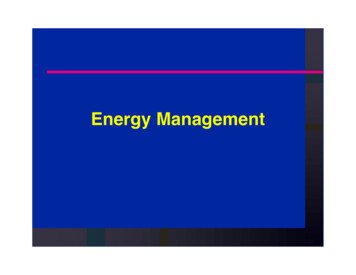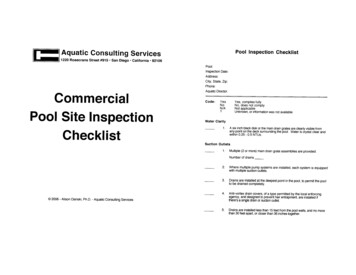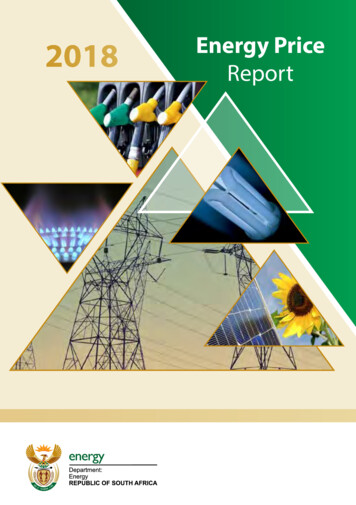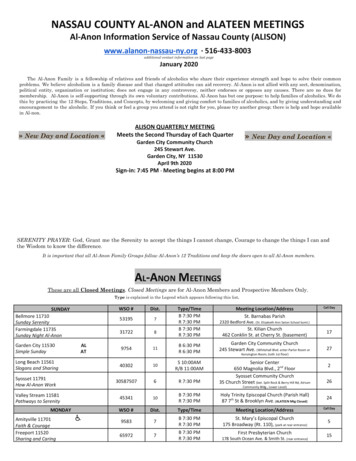
Transcription
Energy Management
Energy Management WindbreaksPool coversSolar & geothermal heating systemsHigh efficiency pool water heatersNatatorium air qualityEfficient pumps and motorsEnergy efficient lighting
Energy Management Plan Train personnel to conserve energyEstablish energy reduction goalsDevelop energy maintenance proceduresCoordinate use of equipmentConduct periodic energy auditsU.S. Dept. of Energyʼs RSPEC! (ReduceSwimming Pool Energy Costs) program For copies of software of fact sheets, call or write:(202) 586-8034 or (800) DOE-ERECEnergy Efficiency and Renewable Energy Clearinghouse,P.O. Box 3048, Merrifield, VA 22116
Heat Loss Radiation Heat lost to the surrounding cold still airEvaporation Heat lost to water dissipationConduction Heat lost throughcontact with a cold objectConvection Heat lost to movingair or water
Factors Affecting Heat Loss Temperature difference between air andwaterPool surface areaRelative humidityAir velocityGeographic location
Energy Loss CharacteristicsU.S. Department of Energy Outdoor Pools 70%20%10%EvaporationRadiationGround Indoor Pools 70%27%3%EvaporationVentilationOther
Evaporation Evaporation is the major source of energy loss frompoolsThe higher the wind speed and water temperature,and the lower the humidity, the greater theevaporation rate1 BTU is needed to raise 1 pound of water 1 degreeFor each pound of 80 degree water lost due toevaporation, 1,048 BTUs of heat are lost from thepool
Windbreaks Use trees, shrubs, fences, windscreens,walls. to shelter the pool surface fromthe windA 7 mph wind blowing across thesurface of the pool can increase energyconsumption by as much as 300%Wind velocity affects rate of convectionand evaporation losses
Pool Covers The most effective way to reduce pool heating costs is to cover the poolReduced heating costs (50 - 70%)Conservation ofmake-up water(30 - 50%)
Pool Covers Prevents dirt and debris from entering poolReduced maintenance time and costsReduced chemical consumptionReduced need to ventilate indoor pools andpre treat outside airReduced rusting and deterioration ofstructural components
Solar Heating Systems Panels can be mounted on a roof, deck rack, or on the groundIdeally, panels should face due South -- but ifwithin 15 degrees East or West of due South,there's little loss of performancePanel angle Summer heating:Winter heating:Year 'round:Latitude minus 10 - 15 degreesLatitude plus 10 - 15 degreesLatitude
Solar Heating Systems Glazed Black chrome-plated copper absorber plates with a low iron tempered glass coveringCan operate year 'round in harsh climatesRequire transfer fluid and heat exchangersA booster pump to lift water to panelsinstalled on a roof may also be needed
Solar Heating Systems Unglazed Inexpensive for use in warm climates and outdoorseasonal poolsWater circulates directly through collectors, using thepool pump, and 2 heat sensors connected to a solarcontroller One sensor measures pool temperature The other measures temperature at the controller surfaceIf temperature differential issignificant, the controller sendsa signal to a motorized valvethat closes and directs waterthrough the collectors
Solar Heating Systems Unglazed Black thermoplastic rubber or polypropylene absorberplates
Geothermal Heat Use of natural hot springs to heat poolsMixing and cooling reservoirsAvailability based on geographic locationPotential problems: sulfur odors, high mineralcontent, aggressive water
Pool & Spa Heaters Fossil fuel heaters Direct firedElectric immersionelementIndirect firedHeat pump Alternative energysources SolarGeothermal
Heating Methods Temperature maintenance:Size is calculated using surface area Intermittent or spot heating:Size is calculated using volume
Heater Ignition Systems Millivolt Heaters Continuous pilot light to ignite burner Banned in some states (CA, NY) on new pool installations Energy wasteIntermittent Ignition Systems AKA: spark ignition, electronic ignition, orpilotless ignition Require electrical hook-up or line voltage
Heater Efficiency Heater Efficiency Heater Output Heater InputOutput Input x Heater EfficiencyEfficiency ratings: Pool gas heaters 75 - 97% Heat pumps400% Electric heaters 100%
Water Column (WC) Unit for expressing pressure1 inch water column 0.0578 ouncesper square inch1/30 of 1 psi28 inches water column 1 psi
Intermittent Heating419,415 BTUs per 1,000 ft2 for 15 rise in 24 hours559,220 BTUs per 1,000 ft2 for 20 rise in 24 hours699,025 BTUs per 1,000 ft2 for 25 rise in 24 hours838,830 BTUs per 1,000 ft2 for 30 rise in 24 hoursx BTU output(1,000 ft2)% E ratingBTUs input
Temperature Maintenance157,500 BTUs per 1,000 ft2 for 15 temperature rise210,000 BTUs per 1,000 ft2 for 20 temperature rise263,000 BTUs per 1,000 ft2 for 25 temperature rise315,000 BTUs per 1,000 ft2 for 30 temperature risex BTU output(1,000 ft2) ]% E ratingBTUs input
Pool Heater Sizing ExampleFuel:Heat method:Dimensions:Surface area:Desired temperature:Max. temperature rise:Efficiency rating:Heater output:Required heater input:Natural gasTemperature maintenance75' x 48'3,600 square feet85 25 97%1,000 ft2/25 rise 263,0003.6 x 263,000 946,800 BTU946,800 .97 976,082 BTU
Commercial Pool HeaterSizing Pool surface area (ft2) x 15--a constant that represents the BTUs required to raise water temperature onedegree per square foot of surface areax Desired increase in water temperature overambient air temperatureExample:(6,150 ft2) x (15) x (25 ) 2,306,250 BTU
Heater Installation Establish adequate clearances Oxygen is needed for combustion to occurInstall on a level, non-combustible baseMinimize the effects of windCompensate for altitude For each 1,000 feet in altitude above sea level, increaseheater size by 4% Insure an adequate supply of fuel--natural gas 5-10WC, LP gas 11-14 WC Anything that restricts the flow of gas may cause problems Incorrect gas volume will cause over or under firing of heaterCorrectly size the heater
Heater Installation Correctly size the hydraulic system Water flow can erode heater piping and componentsInstall a thermostat and high temperature limit switchInstall a flow or pressure switchInstall a gas pressure regulatorLocate the heater away from combustible materialsKeep pool chemicals away from the heater Corrosive fumes will damage the heaterBond and ground the heater to prevent hazards ofelectrical shockInstall the heater downstream of the pump and filter,and upstream of chemical injection equipment
Heater Installation Install a fireman's switch If a timer is installed, a separate low voltage fireman's switchshould also be installed to deactivate the heater severalminutes before pump is turned off Maintain proper water balance Calcification or corrosion and early destruction of heaterelements will result if water is not balanced Install heater close to the pool to minimize heat lossInstall a copper, stainless steel or CPVC heat sinkbetween the heater and pipingInstall check valves in line between the filter andheater, and between the heater and chemical injectionequipment
Heater Installation Properly vent to insure combustion and adequateexhaustionInstall in compliance with codes and regulations: ANSI Z223.1-1984: National Fuel Gas Code ANSI Z21.56 Gas Fired Pool & Spa Heaters American Gas Association Underwriters LaboratoriesRead the instruction and maintenance manualprovided by the manufacturerTo avoid accidents: Only look at the pilot light with a mirror Relight the pilot with long matches or a lighting tool Use dish soap to test for leaks -- don't use matches
Heat Pumps Energy efficient method of reclaiming and recyclingenergyGenerate heat by using energy taken fromsurrounding air and transferring it to pool waterFan assembly draws air through the evaporatorEvaporator collects heat from the air and warms therefrigerant gas Usually freon, a non chlorine fluorocarbon When gas is compressed temperature increases Higher the ambient air temperature, the faster andbetter heat pumps work
Heat Pumps Compressor compresses the warmed refrigerantHeat exchangertransfers heat absorbedby refrigerant in thecompressor to thewater flowingthrough adjacentpiping
Heat Pumps Gas cools from coming into contact with water, and isthe re compressed and reheatedHeat pumps are rated in tons like air conditioners,rather than like heaters 1 ton equals the amount of energy needed to keep1 ton of ice frozen at 32 for 24 hours 1 ton equals approximately 15,000 BTUs
Co-generation Generation of bothelectric power andheat on-siteEnergy efficientand economicheating method
Co-generation Pool acts as the heat sink to transfer the heat byproduct created by the (oil, natural gas or diesel) engine,electrical generator, radiator, and exhaust equipmentEngine turns a generator which produces electric power(kilowatts)Utilize heat exchangersProblems: Initial cost of equipment Space requirements High maintenance and downtime Noise
Energy Cost of Operating aPool Circulation Pump(Motor amps x Voltage ) 1,000 kwhx cost per kwh (from electric bill)x hours per day pump is operatedx days per year pump is operated average cost to operate pump per year
Illumination Levels Minimum wattage: 3.5 - 5.0 watts per square foot ofwater surface area (incandescent)Illuminating Engineering Society, NCAA and U.S.Swimming recommend that pool lighting be based onillumination levels (luminous output) rather thanwattage (energy input)Indoor pools: 100 footcandlesOutdoor pools: 60 footcandlesPools used for elite level competition: 150 - 200 fcTest using a light meter or photometer
Natatorium Lighting Cost of light bulbFixtureWattage and lumens/wattBulb replacement (frequency, life expectancy, labor costs)Color IncandescentWhite Low pressure sodiumBug light yellow High pressure sodium Pinkish-yellow Mercury vaporGreenish-yellowGlare potentialEfficiency (cost of operation)Start-up or re-strike requirements (warm-up or instant light)
Lighting Incandescent Halogen Fluorescent High intensity discharge Metal halide Mercury vapor High pressure sodium Low pressure sodium Fiberoptics Sulfur (experimental, donʼt burn out, 3 94 mercury vapor bulbs)
Light Comparison Color -Metal halide, fluorescent, incandescentLow pressure sodium, mercury vapor, highpressure sodium Glare -Fluorescent, metal halideHigh pressure sodium (alternate with amber lights),Incandescent Candlepower (lumens/watt) -Metal halideFluorescent
Light Comparison Instant light -FluorescentMercury vapor, metal halide, high pressuresodium Life expectancy -Fluorescent, metal halideIncandescent Energy efficiency -FluorescentIncandescent, mercury vapor
Fluorescent BulbsCompact fluorescent bulbs use 75% lesselectricity and last 10 times longer thanconventional incandescent bulbs. Overits lifetime, one compact fluorescent bulbwill save enough energy to cut 600pounds of carbon emissions from a typicalcoal-fired electric plant.Smithsonian display - Museum of Natural History
Lights Deck and area lightingUnderwater lightsSecurity lightsExit lightsNatural lightExterior building lights, parking lotlighting
Wet NicheUnderwater Pool Lights Typical pool lighting circuit: Light bulb Lamp assembly(lens, gasket, face plate,set screw, washer) Recessed nicheCord, conduitGround wireJ-box or transformer On/off switch, breaker box Main circuit box(4ʼ from pool and 8” above waterline)(fuses, breakers, GFCI)
Wet NicheUnderwater Pool Lights Mounted in pool wall 18” below the water surfaceSealed, water-tight fixtureCooled by surrounding water
Dry NicheUnderwater Pool Lights Mounted in niches that extend through the pool wall and are separated from the water bya glass lensServiced from behind the pool wall from anaccess tunnelAir and water cooledHousing, lens, lamp assembly, junction box
Energy Management Plan Train personnel to conserve energy Establish energy reduction goals Develop energy maintenance procedures Coordinate use of equipment Conduct periodic energy audits U.S. Dept. of Energyʼs RSPEC!(Reduce Swimming Pool Energy Costs) program For copies of software of fact sheets, call or write: (202) 586-8034 or (800) DOE-EREC










